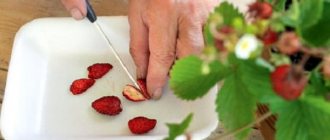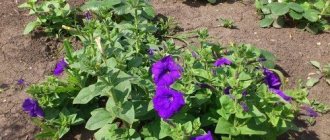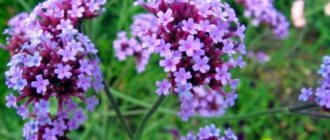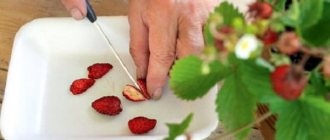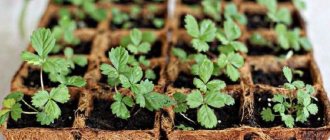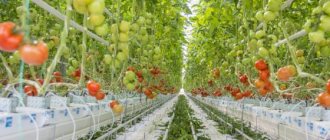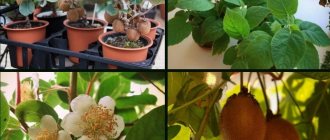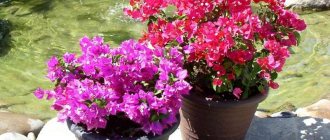In this article you will learn how to grow pineapple at home. At first glance, this seems like a complicated matter, but in reality everything is very simple.
Increasingly, on home windowsills you can find growing lemon, tangerine, mango, pineapple and many other exotic and not yet quite familiar to us fruits. It is quite possible to grow such a miracle at home; all you need is desire and patience. Today we will talk about growing one of the most popular fruits at home - pineapple.
How to choose the right planting material for growing pineapple?
It is important to immediately note that this plant can be grown not only with the help of its “tuft”; seeds and root cuttings of an adult plant are also used for these purposes. If you want to plant this exotic plant at home using its top, then first you will need to purchase a suitable pineapple.
A ripe and pleasantly smelling fruit would be suitable in this case :
- First, appreciate the aroma of pineapple. If you smell the fruit, but do not feel any odor, this indicates that it is not yet ripe and, accordingly, it will not be suitable for planting. The ripe fruit has a fairly pronounced and very pleasant smell.
- Now look at the fruit. It must be intact, not deformed or rotten . The fact that the fruit has begun to rot will be indicated by dark spots on it and between its scales. Also evaluate the color of the pineapple, it should be uniform. Most often, a ripe fruit has a yellowish color; if the fruit is green, this indicates its immaturity.
The pineapple should be ripe and aromatic
- For planting, you need a moderately ripe pineapple ; an overripe fruit is definitely not suitable. To determine if it is suitable for planting, press it lightly. If the fruit is overripe, it will be very soft, you can literally pierce it with your finger, while green pineapple, on the contrary, will be hard. If, when you press on the scales of the fruit, they seem to spring back, then this means that the fruit is moderately ripe.
- It is also very important to examine the very top of the fruit . It should be green and its edges a little dry. If the leaves are yellow or rotten, then this fruit cannot be taken.
- Another sign of a suitable fruit is a hollow sound when you tap it.
As for pineapple seeds, you need to buy them based on the following tips:
- If you are careful, you will notice that the pineapples sold in our stores, as a rule, do not have seeds. The thing is that such pineapples are bred and not wild. Sometimes pineapple contains such seeds, but more often than not they are unsuitable for further manipulation.
- That is why it is recommended to buy seeds in special stores to grow this exotic miracle.
- The seeds must not be dry or damaged; you also need to pay attention to their size - they should not be too small.
Growing from seeds
Regarding root cuttings , you can take cuttings from a plant during fruiting or after this process. It is important that the shoots to be separated are of sufficient size, approximately 15-20 cm. In this case, the plant from which the cuttings will be taken must be absolutely healthy and strong.
Pineapple: plant description
Pineapple is a herbaceous plant with a stem sprouting from the center.
In the center of the stem, at the top there is an inflorescence, which after fertilization turns into infructescence.
Outwardly, it can be seen that the individual parts of the berries of the fruit grow together into one fruit - a pineapple. The stem is surrounded by a rosette - fleshy and thick leaves.
The pineapple fruit has an oval, cylindrical shape and consists of numerous individual small parts fused together. A rosette of leaves forms at the top.
The dense scaly shell of the ripe fruit has a dark green, yellow, brown or even reddish tint. Inside the fruit there is bright yellow pulp. It has a pleasant taste and good aroma. Ripe pineapple fruits reach a weight of 4-5 kg.
How to grow a pineapple from the top at home: preparation
It should be noted that most often this exotic fruit is grown in this way, since it is the fastest and easiest.
The success of such cultivation directly depends on the quality of the planting material and how correctly it is prepared for planting. So, first, choose a pineapple based on the above recommendations. Next, you need to separate the “tuft” from the fruit itself. You can do this in several ways:
- Take all the pineapple leaves in your hand and squeeze them quite tightly. Next, carefully turn the greens. If the pineapple was chosen correctly, the top will turn and separate from the main part of the fruit. In this case, a little stem should remain at the bottom of the top.
- If it is not possible to separate the planting material in this way, use a knife. Carefully cut off the top of the fruit along with the top. Next, use a knife to separate the entire edible part from the top. Be careful, if even a little fruit remains along with the “tuft”, this will lead to its rotting.
- When you, using one of the methods, separate the planting material from the fruit, also carefully remove a couple of lower leaves from the “tuft”.
Separate the top
- After this, hang the planting material in a dry place and leave it for a day. The top should dry out a little.
- After the specified time, take a container of water, preferably a glass, and place the top in it. Be careful, there should only be a bare trunk of the “crest” in the water.
Place in water
- Now you need to move the planting material along with the glass to a windowsill or table and wait for the roots to sprout. As a rule, this process takes about 1 month.
- The water in the container needs to be changed from time to time, and you also need to make sure that there is always enough of it.
- When the top takes root and they reach about 3 cm, the planting material will be ready for further manipulations, which you will learn more about below.
Landing
Pineapple is a crop that is demanding when it comes to living conditions. For successful cultivation, you need to carefully select the planting container and soil.
How to choose soil and container
The pot for planting should be low and wide. You can take a deep container, but in this case it must be filled 2/3 with a drainage layer. Preference should be given to clay pots, as the roots receive more oxygen in them.
You can use ready-made mixtures for palm trees as soil or make your own soil mixture. To do this you need:
- 3 parts of turf;
- 3 parts acid peat;
- 2 parts rotted humus;
- 1 part sand.
A ready-made substrate for orchids is well suited for growing pineapple.
Holes and drainage holes must be made at the bottom of the pot to prevent liquid stagnation.
Landing Features
Rules for planting cut tops:
- Make a small mound of soil in the center of the container.
- The top is placed on the top of the earthen mound and slightly pressed into the ground.
- The soil is sprayed with warm water, avoiding excessive moisture.
- The top of the pineapple is covered with a cut plastic bottle, glass or cellophane.
- Place the container with pineapple in a bright, warm place.
Rooting occurs by the end of the second month. The beginning of this process can be determined by the growth of leaves. As soon as they begin to grow, the shelter can be removed and after a week the plant can be moved to a permanent location.
Sprouted roots are very fragile, so the leafy crown must be planted very carefully. Landing rules:
- The top is buried 2-3 cm into the soil.
- Supports secure the plant so that it does not fall under the weight of the leaves.
- Water with warm water, avoiding excessive moisture.
The plant planted in this way is left in the same room where the roots were sprouted. Spray with warm water daily. After 2-3 weeks, the plant is transferred to a permanent place.
How to properly plant a pineapple from the top and care for it after planting?
So, after the planting material has been prepared, you can begin planting the plant itself. At this stage, it is necessary to pay attention to the soil in which we will plant the plant. Suitable for our purposes:
- Self-prepared soil, which can be obtained by mixing sand, peat and ordinary soil in equal proportions
- And also soil for cacti purchased in a special store.
- And one more thing, in addition to the earth, we will need expanded clay
As for the capacity, to begin with it will be enough to take a small pot, which will have a volume of about 1 liter.
- We take a container and pour expanded clay onto its bottom. Its layer should be large enough, since this material will serve as a drainage system.
- Next, fill the container with the selected soil.
- It is recommended to pre-moisten the soil, but do not make the pot completely muddy.
- Now make a hole in the ground; its depth should be such that the top trunk can easily fit into it.
- Carefully place the “tuft” in the hole, fill the hole with earth, and lightly tamp it down. It is permissible to sprinkle the lower leaves a little with soil, but the rest should not be immersed in the ground.
- Check that the top is firmly anchored in the ground and does not fall. Water the plant a little.
Growing Pineapple
- After carrying out all the above manipulations, it is necessary to “hide” the plant in a bag. In this way, the conditions necessary for its rooting will be created. Remove the bag from the pineapple regularly to ventilate it. You can completely remove the bag when the fruit has taken root.
- Now choose a permanent place for the planted fruit. The room in which the pineapple will grow must be warm, without drafts. At the same time, you cannot place the container with the plant in a place where it will be exposed to direct sunlight, near radiators, heaters, stoves, etc. Pineapple is contraindicated in cold, drafts, dry air and constant exposure to the sun.
- Also water your pineapple regularly , using only warm water. As for its quantity, it all depends on the requirements of the plant. As soon as the top soil becomes dry, water the fruit generously. Do not forget, it is important to moisten the soil not only on the surface of the pot, but also below.
- You can periodically feed the plant with fertilizers, this will also have a beneficial effect on its growth and development. You can buy them at any flower shop.
- Next, keep an eye on the plant; after about a couple of months you will see that the leaves of the “tuft” disappear, and new ones appear in their place. This is a good sign and will indicate that the plant has taken root and is actively growing. Carefully remove dry leaves so that they do not interfere with the growth of new ones.
- After about 1-1.5 years, transplant the plant into a larger container. This can be done at almost any time, with the exception of the flowering period. You need to replant a pineapple without shaking off the soil from its roots.
Care errors
In addition to pests, pineapple can wither due to improper care. Therefore, take appropriate measures in time:
- If the tips of the leaves dry out, increase the humidity in the room.
- Mold has appeared on the soil - remove it with a napkin and significantly increase the intervals between waterings.
- Light spots on the leaves - treat the leaves with a weak solution of potassium permanganate.
- If the roots are rotten, cut off the bottom of the trunk, leaving only healthy tissue, and re-root the top. In the future, do not keep the pineapple pot in too cool conditions.
- Slow growth - move the flowerpot to a warmer place and water with slightly warmed water.
How to grow pineapple at home from seeds?
This method of growing such exotics is considered the most difficult and requires certain skills in this matter, as well as great patience.
- Purchase plant seeds from a specialty store. As a rule, they do not require any additional processing.
- Prepare a container and fill it with soil made from soil, sand and peat (mix everything in equal proportions).
- Planting material is sown in the prepared soil to a depth of about 1.5 cm. It is not worth sowing the seeds deeper, they may simply not sprout.
- Now moisten the soil with warm water and wrap the container in film or use a plastic bag.
- Provide future plants with the necessary conditions. To do this, place the container with planting material in a warm place.
- After 2-6 weeks you will be pleased with the first small sprouts. How quickly you see seeding results depends on the temperature at which the seeds develop. The warmer the room, the faster the seeds will germinate.
You can grow pineapple from seeds
- Small sprouts also need care. Be sure to water them and also feed them with the necessary fertilizers and do not leave them in the scorching sun. Regularly remove the bag or film to ventilate the seedlings.
- When you see that the pineapple leaves have grown and reached a length of 5 cm, feel free to pick them. To do this, prepare the soil from soil, sand, peat, humus and charcoal, or buy a ready-made composition in a specialized store.
- Next, also monitor the temperature and humidity levels in the room. If necessary, fertilize the pineapple and replant it in a large container.
If you still decide to try to grow a plant from seeds that you find in a purchased fruit, then before planting, be sure to treat them with a weak solution of potassium permanganate, and then let them dry completely from the liquid.
Where are pineapples grown?
The birthplace of this tropical plant is considered to be South America, or more precisely, Brazil. The first European who was able to appreciate the taste of this fruit was Christopher Columbus. Thanks to the colonialists, over time, the territories with suitable conditions for growing pineapples expanded. They do this in the Philippines, Hawaii, Mexico, India and others.
Pineapple in the apartment
The fruit is grown most often in pots in America and southern Europe. It is better for this purpose to take not the variety sold in the store, but decorative small-fruited varieties. Ways to grow pineapple in an apartment were described earlier. It is worth noting that often the experiment does not give results and this is due to the incorrectly selected fruit for planting.
Growing pineapples in open ground
In areas with a suitable climate, fruits are propagated on plantations. Intensive technology is used using large-fruited, early-ripening varieties. Rooted cuttings with a length of at least 20 cm are planted. The plant is planted in a two-row manner, making sure that there is about 1.5-2 m between the bushes. It is important to leave wide row spacing. Growing pineapple in the countryside in open ground is not easy, since it is difficult to organize suitable conditions.
Growing pineapples in a greenhouse
For propagation in greenhouses, be sure to use the correct soil, for which mix garden soil, peat, humus, perlite and charcoal. When figuring out how to grow a pineapple, it is worth pointing out that for watering it is necessary to use acidified water. Make sure that the liquid does not stagnate. To obtain a harvest, you can fumigate plants with smoke or treat them with acetylene.
How to grow pineapple using root cuttings?
This method is suitable for those who already have an adult plant at home. By transplanting cuttings you can please yourself with a large number of new exotic plants.
- The plant can be propagated in this way during its fruiting or after this process.
- Only those cuttings that have reached approximately 15 cm are considered suitable.
- To obtain planting material, you can use a knife to carefully cut off the shoot or simply tear it off with your hands. We described a similar process earlier when we talked about planting a pineapple from the top.
- The damaged area on an adult plant must be sprinkled with wood ash.
- Now carefully hang the planting material and let it dry for 2-3 days. It must be hung with the leaves facing down.
- Next, you can either germinate the roots of the cutting by placing it in a container with water, or leave it and let the “wounds” overgrow a little, then treat it with wood ash and plant it in the ground. Sometimes only the separated cuttings already have small roots, in this case there is no need to grow them further, you can immediately plant the plant in a pot.
Cuttings
- You need to plant pineapple in a mixture of soil, peat and sand or in ready-made soil, which can be bought at a specialty store.
- The container must have drainage, otherwise the water will stagnate in the pot and the plant will begin to rot.
- After planting, the cuttings need to be watered, covered with a bag and taken to the warmest room. Periodically, the bag needs to be removed and the plant needs to be sprayed or watered a little.
- A couple of months later, after the planted pineapple begins to grow new leaves, evaluate the condition of the plant. Start introducing fertilizing, do not cover it with the bag anymore.
- After 1-2 years, transplant the pineapple into a larger pot.
Feedback from practitioners
For a long time I had a desire to plant a pineapple at home, I was waiting for summer.
They say that winter ones take root very poorly; they probably suffered from the cold in some warehouse. This is surprising, but they reproduce with their green rosette crests. I found a large ripe pineapple with nice green leaves in the store and unscrewed this socket with my hand, as if unscrewing a light bulb from its socket - it was quite easy. Then I dried it on the windowsill. A horizontal position and a period of 3 days to 2 weeks are recommended. I dried it for 3 days, I didn’t have the patience anymore. Then I cut off the dried leaves. Further, as they dry out, they are advised to be removed. In the end, most likely, only one stalk will remain, from which sprouts will come. But this is still far away; you will have to endure from one to several months. Tolerate and take care. I chose sand as the soil for the first planting; I watched in one program that in the homeland of the pineapple there are entire sandy nurseries for growing pineapple seedlings. The sand must be clean and damp. In general, this tropical plant needs water and light, as well as warmth, even heat. There is no place for it on a cold floor or windowsill. One more nuance - you need to water the plant in the center of the outlet - there it has special adventitious roots to collect moisture, and also often spray it with warm water, sometimes acidifying it with lemon juice. KOSCHECHKA-BLACK
https://otzovik.com/review_226636.html
New leafy shoots of indoor pineapple come from the center of the stalk
One day I saw redness inside the rosette, and a few days later a pineapple flower.
You know, it’s such a delight, as if I saw a fern flower and made a wish. It’s a miracle to watch how it shoots out an arrow with an inflorescence of small red flowers, then each flower turns into a so-called “navel” of which the pineapple fruit is made, and on the top of the head there is a green crest. Foxy Love
https://irecommend.ru/content/vyrashchivaem-ananas-v-domashnikh-usloviyakh
How to properly care for an adult pineapple at home?
Planting a plant is only half the battle. The most important point is proper care for an already mature pineapple, because without the necessary conditions, the plant will not bloom and certainly not be pleased with the harvest.
- Lighting . This plant loves light and needs enough of it. If in the warm season a pineapple can simply be placed on the windowsill and this light will be enough for it, then in winter you also need to use a special lamp that will help increase daylight hours.
- Temperature. This culture loves warmth very much and, in principle, does not tolerate cold. If the thermometer shows +17 °C, this means that your exotic miracle is already cold. The plant will feel good if it is in a room where the temperature does not drop below +20 °C. For the same reason, you should not place a container with pineapple on a cold windowsill or balcony, especially if it is no longer summer outside. It is important to say that pineapple, like any other plant, senses changes in weather conditions outside the window, so in winter it needs to organize a little rest. At this time, it can be moved to a room with a temperature of approximately +18°C, while watering should be slightly reduced, as well as daylight hours.
- Watering. Watering should not be done very often, but the amount of water should be sufficient to moisten the soil not only in the top layer, but also below. A sure sign that the plant needs to be watered is dry soil. The procedure must be carried out exclusively with warm water. In addition to watering, the plant is also sprayed with a spray bottle; such a “shower” should be carried out on hot days.
Homemade pineapple needs proper care
- Fertilizer. Caring for an exotic plant can be considered good only if regular feeding is carried out. Pineapple needs different fertilizers; a consultant at a flower shop will help you choose them. As a rule, fertilize the plant more than 2 times a month.
- Transfer. Pineapple needs replanting every year. At the same time, you need to know that the plant is being replanted without disturbing its roots, that is, there is no need to shake off the soil from them. The volume of the container needs to be increased quite a bit.
- A container in which a pineapple grows. Such a container can be completely different, the main thing is that it matches the size of the plant. It must also be said that the container must have drainage, otherwise the pineapple will die sooner or later, never delighting you with its flowering and fruits.
What conditions does a pineapple need to grow successfully?
Pineapple, when grown at home, is very demanding on the conditions that will be created for its successful ripening. Since this is a tropical plant, it is extremely important to maintain proper lighting, temperature and humidity.
Lighting
Pineapple needs at least 6 hours a day, regardless of the time of year, to be in a well-lit place. In summer, the plant can be placed on the balcony or in the garden, in a moderately lit place. During the cold season, pineapple should be kept on the south side to evenly receive sunlight.
The plant should not be rotated, as this can slow down its growth; one-sided lighting is sufficient for it. If the time of year and weather conditions do not allow sunlight, then the pineapple can be illuminated with additional lighting - fluorescent lamps.
Just keep in mind that when using lamps, the pineapple must receive lighting for at least 8 hours a day.
How to make a pineapple bloom: special care
Unfortunately, pineapple flowering at home does not always occur. Often, a plant is helped to bloom by stimulating it with various methods for this process.
- Let's start with the fact that only an adult and healthy plant can bloom and, accordingly, bear fruit for 2-3 years.
- To speed up this process at least a little, impatient owners of exotic plants use special fertilizers.
One of the most popular top dressings is the following:
- Approximately 10 g of carbide should be added to 1 liter of clean water.
- After the reaction has occurred, you will see that a small sediment has appeared in the container - we don’t need it
- Therefore, pour about 25 ml of clean liquid into another container and pour it over the pineapple
- We pour the solution directly onto the leaves, trying to get into their middle, from where the flower and, accordingly, the fruit will then appear.
- This procedure must be done for 3 days in a row.
Pineapple blossom
To use another method, follow these instructions:
- The plant must be “hidden” in a bag, and a 0.5 liter container of water must be placed in the pot.
- Add 5 g of carbide to the water daily and quickly close the bag. The bag must be closed tightly so that the substance released during the reaction does not escape beyond its boundaries. The procedure must be carried out for a couple of days in a row
You can use another simple method. To do this, the plant is stimulated by fumigation with smoke. It is important to note that the first method is much more effective than the others. If all procedures were carried out correctly and the plant was healthy, then after a couple of months you will see a peduncle. After this, the ovary and fruit will appear, which will ripen for about six months.
Popular pineapple varieties
At home, you can grow pineapples for various purposes. Reproduction and care are carried out in the same way in all cases.
Pineapple bract
A popular variety of pineapple that has a remarkable feature: when exposed to the sun, its leaves acquire pink-reddish shades. The leaves reach a length of 1 m and have white and yellow stripes. Unlike other pineapples, this species lives for about 7 years. Often used as an ornamental plant. Suitable for breeding at home.
A special feature of the pineapple bract is the presence of stripes.
Pineapple Caena
The bush reaches a height of 0.3–0.5 m and has many dark green leaves. Suitable for planting at home, does not take up much space, and reproduces well by layering. Prefers porous, well-drained soils. The fruits are small, no more than 7–10 cm long and weighing within 0.5 kg, which can be used as food.
Caena pineapple fruits can be used as food
I didn’t grow anything on my windowsill, but now I want to tell you about the Caena pineapple.
This pineapple was given to me in the spring, on March 8th. The pineapple was beautiful, thick, with a beautiful rosette of small red flowers. After some period of time, a small pineapple fruit began to appear, at first green, then began to turn yellow; from the falling of the flowers to the appearance of the yellow fruit, probably half a year passed. The pineapple fruit tastes very, very sweet, soft, not like what is sold in the store. Of course, after peeling there was almost nothing left, but my whole family was able to try and appreciate it. The pineapple (green) itself is not tall, 20–25 cm. And the fruit was about 7 cm. Raspi
https://irecommend.ru/content/frukt-vyrashchennyi-doma
Homemade pineapple: possible pests and ways to combat them
A pineapple can get sick either due to improper care or due to damage by some pests. In both cases, the plant will need urgent treatment, since if you are late with the necessary actions, you will destroy it.
- If you notice that the leaves of an exotic miracle have begun to dry out, reconsider the temperature regime. Most likely the pineapple is not getting enough water. So, if the plant is standing on a sunny window, near a radiator or heater, immediately remove it from there and increase watering. You can also irrigate the pineapple. However, do not get carried away with these procedures, so as not to get another problem - rotting of the roots, etc.
- If the leaves have lost their color or become too faded, this indicates that the plant does not have enough light. If this happens in winter, start using an additional light source; if in summer, move the plant to a sunnier window.
- If you notice that the leaves not only dry out, but also turn black and acquire a dark brown color, increase the humidity level in the room.
- If the plant has been “sitting” in a pot for several years, but does not want to grow at all and does not bloom, add more fertilizers and various nutritional supplements to its diet.
- Curled leaves are a sure sign of drafts in your room. If the pineapple is on the window, especially in winter, be sure to insulate the windows and close all the cracks.
- You see that the pineapple is rotting, reduce watering, check the temperature in the room. Possible causes may be cold and excess moisture.
Pineapple should be protected from pests and diseases
. As for pests, the following are dangerous for pineapple:
- This crop can be affected by spider mites. This pest attacks the leaves of the plant, which simply lose color and fall off. You can fight mites with a solution of dishwashing detergent and purified water. You need to spray pineapple leaves with a similar product.
- Aphids can cause just as much trouble for a pineapple . You can fight it by fumigating the plant with tobacco smoke or treating the leaves with a soap solution.
- Various types of scale insects can also infect pineapple To destroy such pests, you need to carefully remove them from the plant with a cloth previously soaked in a soap solution, then wipe the leaves with a clean cloth soaked in clean water. If the number of pests is large, use more effective means - insecticides. For example, try Actellik.
Growing a beautiful pineapple at home is not so easy, but the effort and time spent are definitely worth it. By caring for the plant, you will receive the most beautiful exotic miracle, which will certainly delight you not only with its unusual flowering, but also with its delicious fruit.
How to stimulate flowering
If after several years the plant does not bloom, the process is accelerated using calcium carbide, which releases ethylene. A tablespoon is infused for a day in a closed glass container, then filtered. A rosette of leaves is filled with the resulting solution, 50 g each, for a week. After a month and a half, a peduncle usually appears. If the plant does not bloom, it has not reached maturity.
Other methods are to put a bag of apples in a bowl with pineapple or once a week to create smoke: leave smoldering paper and a smoking cigarette nearby, and cover the plant. Four procedures are done in a month.
Growing methods
Pineapples are one of the most unusual tropical plants. They can be grown in controlled conditions in temperate climates and even indoors with enough patience and proper care.
Pineapple is a typical representative of bromeliads. Its structure fully corresponds to the characteristics of this family - the long leaves form a dense rosette that grows almost from the ground. Subsequently, an inflorescence with graceful bracts grows from it. The main difference between pineapple and other representatives of bromeliads is fruiting - after it blooms, a large fruit ripens. Typically, pineapple flowering occurs in the warm season. Pineapples are propagated in three ways:
- using seeds;
- using offspring;
- using the top.
Most often, for growing at home, the top of the pineapple fruit is used as planting material. The biggest difficulty is getting roots. This method of breeding pineapples is discussed in detail below.
Useful properties of pineapple
The fruit is widely used in cooking, cosmetology, medicine, and dietetics. Pineapple pulp contains bromelain. This component facilitates digestion and helps get rid of excess weight. The weight loss effect is enhanced by the large amount of fiber, which accelerates digestion and metabolism.
Fresh fruit contains a large amount of vitamins and minerals. In canned form, most of the nutrients are lost. The vitamin C content in pineapple is 1.5 times higher than in lemon.
Bromelain is used in medicine as part of some anti-inflammatory, decongestant and painkillers. Pineapple can be used as an additional remedy in the treatment of cardiovascular diseases, arthritis, and some types of inflammation. Pineapple helps well in treating bruises, abrasions, insect bites and minor burns.
In cosmetology, pineapple is used to lighten the skin and remove age spots. Due to organic acids, with the help of fruit, you can cleanse the skin, strengthen small blood vessels, and saturate the tissues with essential microelements.
There is an observation that people snore less if there is a pot of pineapple next to the bed. Scientists believe that the plant produces increased amounts of oxygen and improves the composition of the air around it. Thanks to this, people with snoring problems begin to sleep better and more soundly, and the noise level from them is noticeably reduced.
The indoor pineapple is sick - what to do?
Pineapple grown at home is often inhabited by a false scale insect with a shell on its body. First, the plant is treated with a soap solution, then insecticides are used - actara, karbofos, actellik. The solution is prepared according to the instructions. Folk remedies are ineffective, especially with a large colony of pests.
With good care, the plant rarely gets sick. The main problem that amateur gardeners face is the appearance of powdery mildew. A grayish coating becomes noticeable on the leaves and stem, the pineapple grows worse, and the greens wither.
Popular articles Pentas flower: how to care at home
Causes of the disease:
- improper (excessive) watering;
- low temperatures combined with high soil moisture;
- infrequent ventilation of the mini-greenhouse and, as a result, condensation settles on the leaves and rots.
Indoor pineapple can be classified as an unpretentious plant.
How to deal with powdery mildew on indoor pineapple:
- The greens are treated with an alcohol solution, fungicides are sprayed - Skor, Fundazol, Tiovit Jack, Topaz, Fundazim.
- Biofungicides based on live bacterial cultures, which have a detrimental effect on fungal flora, have a good effect. Effective biological products - Gamair, Fitosporin-M, Pseudobacterin-2.
When spraying fungicides, take the plant out onto the balcony or into the yard, put on old clothes, protect hair, eyes, respiratory organs, and hands. During spraying, it is strictly forbidden to drink, eat, or smoke.



